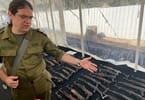KIGALI, Rwanda—Visiting places famous for death is nothing new. You can tour the Nazi concentration camps of Dachau in Germany and Auschwitz in Poland, or the killing fields of Choeung Ek in Cambodia. Tourists sought glimpses of the World Trade Center ruins within days of the Sept. 11th attacks.
Rwanda is another destination where visitors can bear witness to the mass slaughter of innocents. Macabre memorial sites scattered throughout the country mark the horrific genocide in 1994 when extremist Hutus slaughtered 800,000 Tutsis and moderate Hutus.
I toured some of these sites on a trip to the country last year. Churches and schools where thousands of people were murdered have not been sanitized for tourists. They include graphic displays of skulls, bones and even preserved corpses. They were horrifying, yes, and shocking. But they present an accurate depiction of the brutality and inhumanity of war and of genocide.
The most moving site I visited was a genocide memorial at the Murambi school in Gikongoro. A driver picked me up at my hotel in Kigali, the Rwandan capital, at 4 a.m. to begin the three-hour drive from there to the school. His daughter, Foufou Sabati, a university student, accompanied us, serving as an informal translator.
A guide, Rusariganwa Francois, walked me and Foufou through various classrooms. Francois said people flocked to the technical school during the genocide to seek protection from the killers, but ultimately the death squads arrived and murdered them by the thousands.
In addition to a mass grave outside, tables in each classroom are covered with bodies of the dead preserved in powdered lime. Some of the twisted, contorted bodies resist death, others appear to be resigned to their fate. Their faces are preserved in a wide range of expression, from fear to shock to sheer horror. Some defend themselves; others clutch each other. Some are adults, some children, some babies. Machete slashes are still visible on the shriveled remains. The tour continues with a room full of the bloodstained clothing worn by the victims, hanging from clotheslines.
Back in Kigali, the Hotel des Milles Collines is another important stop. It’s a working hotel in Kigali, but it was made famous by the movie “Hotel Rwanda,” which tells the true story of Paul Rusesabagina and the more than 1,000 people he sheltered there during the genocide. The movie was filmed in South Africa, so visitors will not recognize any specific settings, but it’s easy to imagine the scenes playing out, with the large swimming pool being used for drinking water and the frightened refugees hiding in the hallways.
Elsewhere, many ghastly massacres took place in churches where people had futilely gathered, hoping for refuge. My driver took me to the Ntarama church outside Kigali, where thousands more were killed. Purple satin banners hang on the fence outside the weathered red-brick church with a sign declaring, “Never Again.”
The 12-foot high ceiling is pocked with bullet holes and stained with blood. Many of the church’s 10,000 victims were either hacked to death with machetes or clubbed. A statue of the Virgin Mary remains caked in mud. Another display case commemorates the visit of Pope John Paul II. A third case is filled with skulls of the victims staring out in horror at the visitor. A small room near the altar overflows to the ceiling with the unwashed clothing of victims.
A storm had knocked out the power the day I visited, leaving me tiptoeing though the dark as I explored the crypts under the church. Hundreds of skulls and bones, may of them cracked and broken, lined a narrow corridor and only became visible when my camera strobe flashes in the darkened cavern. It was unnerving.
At another site, the Nyamata church, 14 miles south of Kigali, visitors encounter a corridor of shelves, stacked with skulls and bones, inside the entrance. The skulls have holes and gouges from machetes, bullets and clubs. Two massive mounds of leg and arm bones, piled randomly, flank the altar.
These morbid and stark sites may be too shocking for some, but anyone visiting Rwanda should go to the Kigali Memorial Centre, which opened for the 10th anniversary of the genocide in 2004. Organizers built the center on a site containing a mass grave of more than 250,000 victims.
The center provides an excellent historical perspective on Rwandan history and the events leading up to the genocide. Interactive exhibits feature interviews with survivors and discussions of the killings, torture, refugee crisis and recovery. One floor dedicated to child victims features oversized photos of the kids and profiles.
With its walls of family photos, the center serves not only as a memorial to the victims, but also as a place where survivors can come mourn their loved ones. Travel + Leisure magazine reported that when the center opened, many family members came and refused to leave, with some staying and sleeping on the floors for days.
Earlier, in the car, Foufou, my driver’s daughter, had pointed out crumbling houses bombed by the killers, smaller memorials and even pink-clad prisoners convicted of war crimes toiling in the fields.
I asked her why they are allowed to roam out in the open.
“They will not escape,” she said. “They have no place to go amongst their neighbors.”
Indeed, reminders of the genocide were everywhere. A few days before, I had passed an office where survivors waited in line to report people who had participated in the killings. Weeks later I found myself in Arusha, Tanzania, where accused killers were being tried by a United Nations tribunal.
Despite this legacy of death, I was struck by the optimism of so many of the people I met in Rwanda. On the day of our early morning drive, I had watched a sunrise with Foufou and her father, and it seemed in some ways to symbolize the new dawn that people here had embraced.
“There is only one way, and that is forgiveness,” Foufou had told me. “During the genocide there were neighbors killing neighbors, but after the war we are still neighbors. For understanding, you must talk to each other.”
---
If You Go…
KIGALI: Hotels in Kigali include the Hotel des Milles Collines and the Intercontinental. I stayed at the One Love Club, just outside downtown. Large spacious rooms were about $35. The hotel’s proceeds help fund the One Love Project, which provides orthopedic care, prostheses, wheelchairs and crutches to the disabled and other victims of the war. You’ll find a good Chinese restaurant there, while next door, Lalibela, a hip Ethiopian restaurant, has a nice garden setting.
GETTING THERE: Airlines that fly to Kigali from Nairobi, Kenya, include Kenya Airways and Rwandair Express
GETTING AROUND: Taxis are available at the airport, hotels and taxi stands in the city. I hired my driver from a taxi stand for two days to drive me to various genocide memorials.
mercurynews.com
IHE Ị GA-Ewepụ na edemede a:
- A storm had knocked out the power the day I visited, leaving me tiptoeing though the dark as I explored the crypts under the church.
- The movie was filmed in South Africa, so visitors will not recognize any specific settings, but it’s easy to imagine the scenes playing out, with the large swimming pool being used for drinking water and the frightened refugees hiding in the hallways.
- Francois said people flocked to the technical school during the genocide to seek protection from the killers, but ultimately the death squads arrived and murdered them by the thousands.






















